These freewheeling LI commuters skip cars, trains
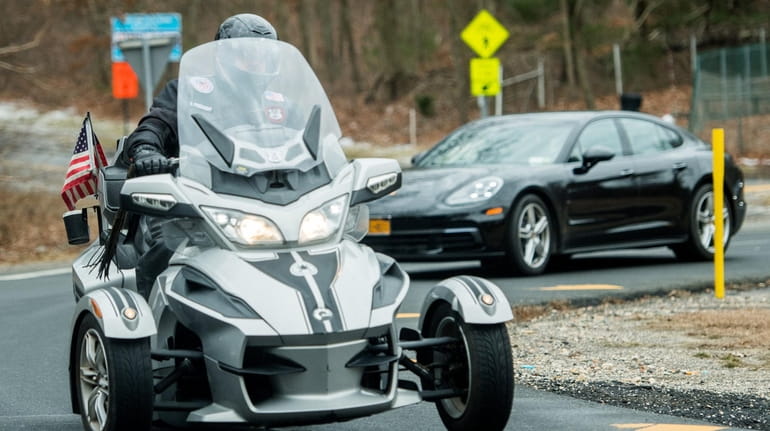
Jeff Zero leaves his job in Farmingdale to commute home to Syosset on his Spyder 3-wheeler. Credit: Andrew Theodorakis
They are Long Island's commuting mavericks.
While nine out of 10 workers hop in a car, truck, van or train to get to work, these Long Islanders take the mode less traveled — walking, running or riding on two wheels or three.
These devoted commuting outliers include an ultramarathoner and college professor who runs to work year-round, a bicyclist who rides through rain and cold, and a motorcyclist who compares the attention his three-wheeled vehicle attracts to being "a rock star."
Statistically, they barely move the needle, given Long Island's tally of 1.4 million workers recorded in a 2017 study by the Census Bureau. But as planners strive to create villages with walkable downtowns and access to mass transit, they may be pointing toward Long Island's future.
Eric Alexander, executive director of Vision Long Island, a Northport-based smart-growth planning group, walks three blocks to work from his Northport home.
"I practice what I preach," Alexander, 48, said.
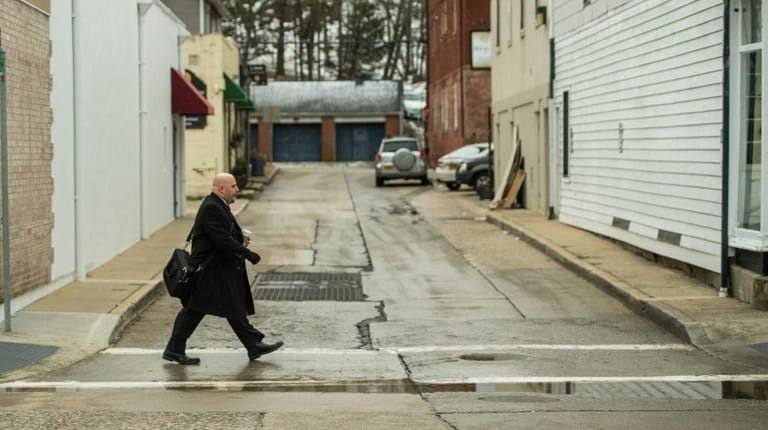
Eric Alexander, executive director of Vision Long Island, walks to work in Northport. Credit: Andrew Theodorakis
But he acknowledged that unpredictable bus service and dangerous roads make it difficult to promote transportation alternatives.
A vast majority of Long Island commuters — 81.9 percent — still battle with bumper-to-bumper traffic on the Long Island Expressway and other roads, a shade lower than the 82.6 percent a decade ago, according to the Census Bureau. Three out of four drivers are alone in their cars, while almost 7 percent carpool, according to the data.
Another 8.4 percent jostle to get a seat on the railroad. That's up from 7.6 percent in 2007.
Other transportation modes remain a backwater.
"Biking, walking and bus service just don't get the dollars," Alexander said of government funding allocations. "There's an inequity in that."
Vehicle registrations on Long Island grew to 2.1 million in 2017 from 1.9 million five years earlier, demonstrating cars' continued popularity, said Robert Sinclair, media relations manager for AAA of New York.
Sprawling Suffolk County, in particular, is "struggling to get people out of their cars," said Lawrence Levy, executive dean of the National Center for Suburban Studies at Hofstra University.
These commuters, however, are not waiting for Long Island municipalities to pour funds into bus service, sidewalks and bike paths.
Instead, they are putting the suburban car culture in the rearview mirror and — to hear them tell it — are not looking back.
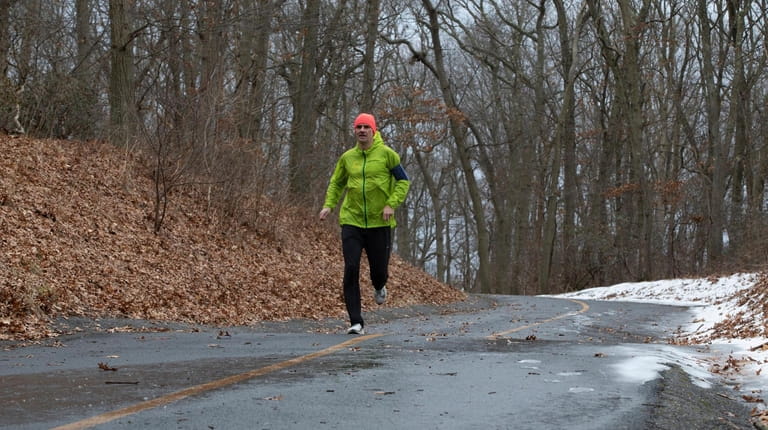
Stefan Judex, of Port Jefferson, runs to his job as a Stony Brook University professor. Credit: Jessica Rotkiewicz
Stefan Judex
Commute (one way): 4 miles
Method: Running
Notable expense: $120 per month for shoes
Stefan Judex views his commute as an opportunity.
He runs 4 miles from his Port Jefferson home to and from his job as professor and interim chair of Stony Brook University's Department of Biomedical Engineering.
An avid runner and triathlete, Judex, 50, uses the route — which can be extended to 10 miles — as a path to maintain his edge for races.
For instance, he's planning to run the Paumanok Pursuit 70k (43.5-mile) Run & Relay ultramarathon — from Rocky Point to Hampton Bays — in April.
The commute typically takes between 30 and 60 minutes. There's a shower in his building, and once a week he totes a backpack with clothing for the week.
About 2 percent of Long Island workers walk — or in the case of Judex, run — to work, according to the Census Bureau estimate. That's about the same percentage as in 2007.
Judex, who estimates he ran more than 2,000 miles last year, said he used a bicycle to get to work his first 10 years at Stony Brook, but has switched to running in the last decade.
"It totally helps me mentally to let off steam and get balanced again," he said. "There's nothing much going through my mind. This is what rejuvenates my mental state."
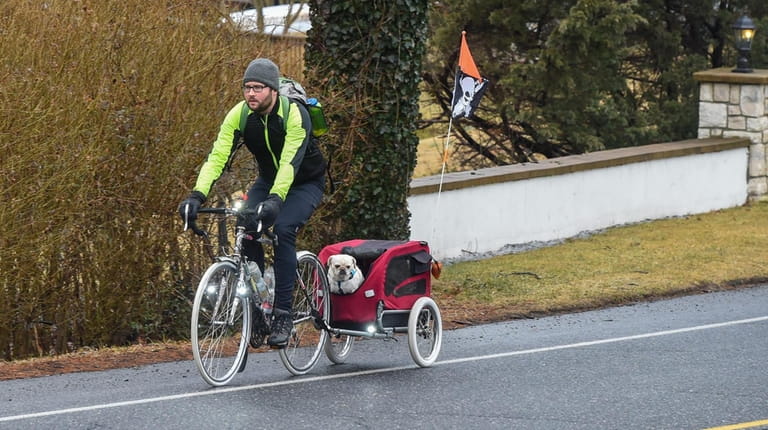
Kevin Motel bicycles to his job at Cycle Fast in Huntington Station, along with his dog Hubble. Credit: James Carbone
Kevin Motel
Commute (one way): 3-1/2 miles
Method: Bicycling
Notable expense: $1,299.99 bicycle purchased in 2014
Kevin Motel said his last car "kicked the bucket" in the summer of 2014.
He lives with his fiancee, who has a car, but he bikes to his sales job at Cycle Fast USA, a bike shop in Huntington Station.
The only exceptions: On fewer than 15 days per year when the weather is exceptionally bad, he catches a ride.
"You get tougher regarding the weather," he said. "You plan a little bit better. I definitely 100 percent love riding my bike instead of driving my car."
Three or four days a week, Motel brings his 3-year-old dog Hubble, a pug mix, to work in a bike trailer.
Bicycling to work, however, remains a decidedly niche method on Long Island. While 6.5 percent of commuters rode bicycles in alternative-culture hub Portland, Oregon, according to 2017 Census estimates, only about a quarter of 1 percent of Long Islanders did.
Motel, 32, said his 5-year-old Trek Touring bike has about 10,000 miles on it, and there are few additional costs.
"I am the motor," he said.

Jeff Zero says the attention his Spyder 3-wheeler attracts makes him feel "like a rock star." Credit: Andrew Theodorakis
Jeff Zero
Commute (one way): 10 miles
Method: Motorcycling on a three-wheeler
Notable expense: $12 per week in gas
Driving a three-wheeled motorcycle like Jeff Zero's Can-Am Spyder is not for shrinking violets.
"You feel like a rock star," he said. "Wherever you go, people are pointing and waving."
Zero bought his 2010 Spyder for $12,000 about four years ago, but he only began using it to commute regularly in the past year. Before that he drove his 2002 Jeep Grand Cherokee.
The Census Bureau lumps motorcycles with taxis and "other means" of commuting. But even combined with ride hailing, the category amounted to less than 1 percent of Long Island workers in 2017.
Zero, vice president of the recently formed Long Island chapter of the US Spyder Ryders, commutes from Syosset to Farmingdale, where he works in a machine shop programming computerized tools. He only drives his Jeep in the most severe weather.
Heated gloves and a jacket liner that plug into the Spyder's battery ward off the cold, he said.
Zero also uses it to go to the Syosset Volunteer Fire Department, where he is an emergency medical technician.
For Zero, 61, the Spyder adds a "fun factor" absent from a typical commute.
"I get home from work, and the first thing my wife says is: 'Can we go out for a ride?' " Zero said.
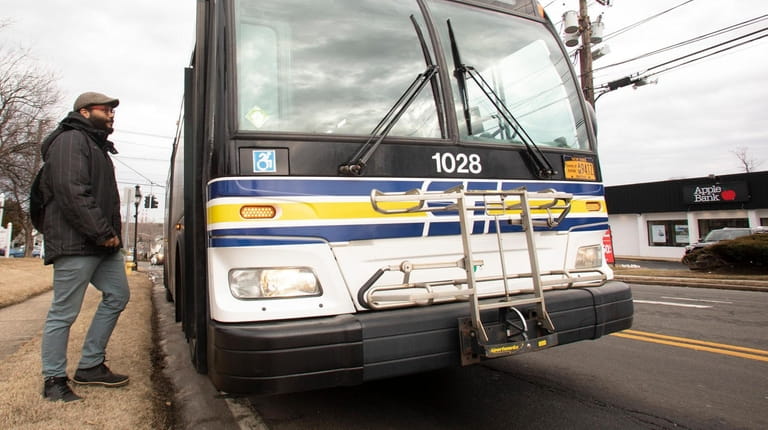
Aaron Watkins-Lopez, of Stony Brook, takes the bus home after work in Setauket. Credit: Jessica Rotkiewicz
Aaron Watkins-Lopez
Commute (one way): 4 miles
Method: Bus
Notable expense: $5 per day in bus fare
Aaron Watkins-Lopez shuns the car culture that clogs Long Island's roads.
The Stony Brook resident is the rare suburbanite who has neither car nor driver's license.
"I don't feel comfortable driving," he said. "Fiscally, it was something I never wanted to put money into. I preferred to put money into trips abroad. I've gone to England. I've gone to Dubai."
Only 1.7 percent of Long Island commuters joined Watkins-Lopez in using buses as their primary commuting vehicle in 2017, according to the Census.
Watkins-Lopez, 27, said that a smartphone app that locates the bus has made his commute more manageable.
Unlike jumping in a car and going, however, bus riders need patience and shoe leather.
Watkins-Lopez has a 10-minute walk to and from bus stops to get to his job as an administrative assistant at Setauket Presbyterian Church.
"Buses can get you to most places," he said. "It's just a matter of planning."
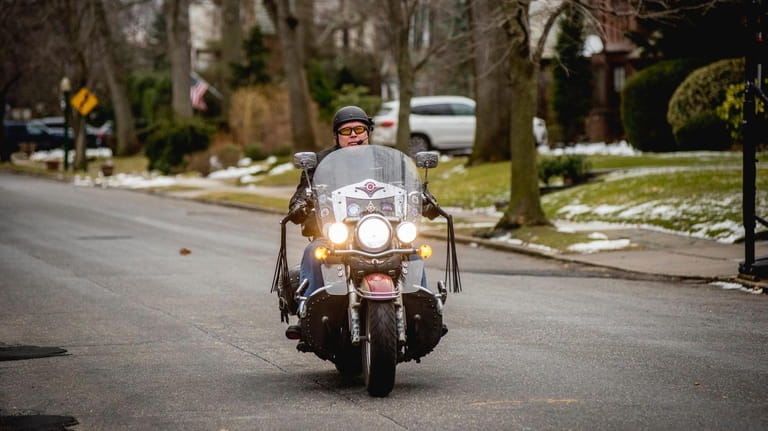
Zach Slavin leaves his Rockville Centre home on his motorcycle, headed to work in Manhattan. Credit: Johnny Milano
Zach Slavin
Commute (one way): 25 miles
Method: Motorcycle
Notable expenses: Free parking and round-trip on 1.25 gallons of gas
Zach Slavin figures he gets double the gas mileage and pays half the tolls by driving his motorcycle from Rockville Centre to his job as an IT project manager on Park Avenue South in Manhattan. Parking is free.
"I'm saving between $30 and $40 a day" in tolls, parking fees and fuel compared to driving a car, he said.
Slavin, 60, said he has been riding his 2009 Kawasaki Vulcan 900 Classic LT to work about 20 days a month for the past three years.
"I ride [when temperatures are] 24 degrees and up as long as the roads are dry," said the retired NYPD lieutenant. Other days, he drives a 2018 Nissan Rogue.
Slavin, who is a member of the Blue Knights, a police motorcycle group, said his commute typically runs about an hour.
"Psychologically, it's invigorating," he said. "Even if I have a bad day at work, I get a motorcycle ride at the end of the day."

Lisa Hendrickson commutes up the stairs in her Port Washington home. Credit: Newsday/J. Conrad Williams Jr.
Lisa Hendrickson
Commute (one way): 13 steps
Method: Walking
Notable expense: $0 for parking and fuel
Perhaps the most radical alternative to commuting is to eliminate it altogether.
Lisa Hendrickson used to take the Long Island Rail Road to jobs at public relations firms in Manhattan's Flatiron District.
More than 20 years ago, she struck out on her own, founding LCH Communications, based in her Port Washington home.
She figures her "commute," which amounts to walking up a flight of stairs, saves her about $500 a month.
Hendrickson, in her mid-50s, uses conference calls to stay in touch with clients around the country. Google Docs and emails help her collaborate with writers and editors who work for the agency.
Scheduling is flexible. An evening conference with West Coast clients can allow for a morning yoga class.
"I don't miss commuting," she said.
Long Island commuting by the numbers:
Cars, trucks, vans: 81.9%
Railroad: 8.4%
Work at home: 4%
Walking: 2%
Taxicab, motorcycle or other: 0.87%
Subway: 0.8%
Bicycle: 0.26%
Source: Census Bureau 2017 American Community Survey 1-Year Estimates

Updated now Newsday travel writer Scott Vogel took the ferry over to Block Island for a weekend of fun.

Updated now Newsday travel writer Scott Vogel took the ferry over to Block Island for a weekend of fun.

